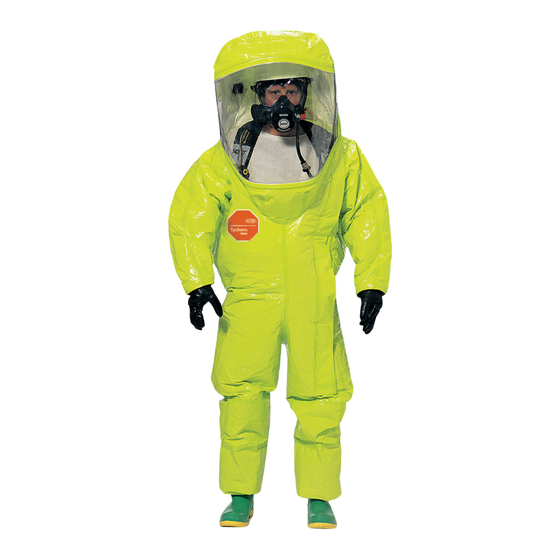- ページ 12
安全装置 Dupont Tychem VaporのPDF ユーザーマニュアルをオンラインで閲覧またはダウンロードできます。Dupont Tychem Vapor 20 ページ。 Garments

User Manual for DuPont
Avoid Exothermic Reactions
Certain chemicals produce a large amount of heat when
they contact water. If your garment is heavily contaminated
with a water-reactive chemical, there is a possibility that the
garment may be damaged during field decontamination
with water. Remove the excess water-reactive chemical
with dry sand or non-reactive absorbent before using a
water decontamination procedure.
Supplied Air Line Limitations
To connect to an external supplied air-line system,
encapsulating garments must be equipped with the
appropriate NIOSH approved garment pass-through. Do not
rely upon this pass-through connection as a physical anchor
for a tether line. Excess force pulling on this pass-through
fitting may result in permanent damage to the garment and
possible injury to the wearer.
Avoid Suffocation
Do not attempt to wear an encapsulating chemical
protective garment without a supplied fresh air respirator.
Use separate, user-supplied, full-face respiratory protection
such as an open circuit, self-contained breathing apparatus
(SCBA) or an external, breathing air quality, air-line system
with garment pass-through and escape bottle.
Never Use Pure Oxygen
The use of 100% oxygen in encapsulating garments
presents serious fire safety and health hazards. Use only
breathing quality compressed air or air-line breathing air.
12
Tychem
Encapsulated Level A and Encapsulated Level B Suits
™
®
Attached Socks
The socks attached to Tychem
to be worn inside outer boots. These socks do not have
sufficient durability or slip resistance to be worn as the
outermost layer.
Communications
An encapsulating chemical protective garment often
hampers clarity of voice communications. Consider using
a personal communication system to improve voice clarity.
The wearer may also use hand signals to communicate.
Positive Pressure
Excessive internal positive pressure can damage
encapsulating garments. Do not inflate above a pressure of
8 inches water column.
Use of Adhesive Tape to Seal Chemical Garments
If properly done, taping of PPE interfaces may reduce bulk
material flow, but cannot be relied on to provide a liquid-
tight or vapor-tight seal. Additionally, during an emergency
situation it may be difficult to carefully apply such tape.
Therefore, taping is primarily viewed as a means to hold
PPE items in place e.g. to hold a hood over a respirator face
piece, a sleeve over a glove, a pant leg over a boot, or to
keep a closure flap closed. Taping does not provide reliable
liquid or gas barrier performance.
garments are designed
®
